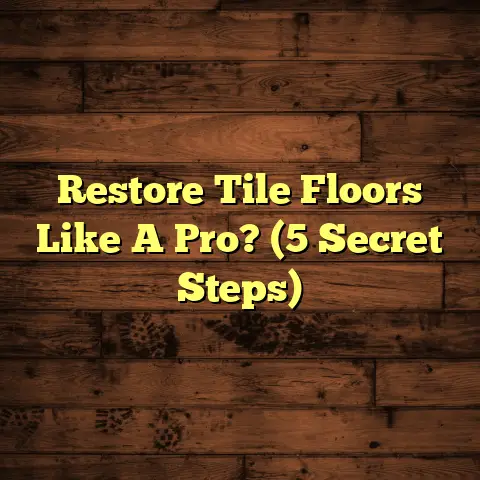DIY Castile Soap Carpet Cleaner? (9 Residue Risks!)
These days, everyone’s looking for greener, more natural cleaning solutions. I get it!
The shift towards eco-friendly products is HUGE, and it’s driven by a real desire to ditch those harsh chemicals.
We’re all becoming more aware of the nasty residues that conventional cleaners leave behind, lurking in our carpets, potentially affecting our health and the environment.
That’s where Castile soap comes in.
This stuff has been around for centuries, and it’s making a serious comeback as a versatile, eco-conscious cleaner.
It’s great for everything from washing your face to mopping your floors!
But can it conquer the carpet cleaning challenge? Well, yes and no.
While Castile soap offers a fantastic alternative to chemical-laden cleaners, it’s not without its quirks.
I’m here to give you the lowdown on using Castile soap for carpet cleaning, but more importantly, I want to arm you with the knowledge to avoid the dreaded residue risks.
Trust me, I’ve seen the consequences firsthand!
Section 1: Understanding Castile Soap
So, what exactly is Castile soap?
Simply put, it’s a vegetable-based soap traditionally made with olive oil.
The name “Castile” comes from the Castile region of Spain, where olive oil soapmaking originated.
Nowadays, you’ll find Castile soap made with other vegetable oils like coconut, palm, and hemp.
What makes it so special? It’s biodegradable, non-toxic, and incredibly versatile.
It’s a far cry from the synthetic detergents loaded with sulfates, parabens, and artificial fragrances that dominate the cleaning aisle.
Castile soap is effective because of its ability to emulsify fats and oils, allowing them to be washed away with water.
This makes it a great cleaner for all sorts of things, including:
- Personal Care: Body wash, shampoo, hand soap
- Household Cleaning: Dish soap, laundry detergent, all-purpose cleaner
- Even Carpets! (with caveats, of course, which we’ll get into)
The benefits of using it as a carpet cleaner are clear: it’s natural, gentle, and effective at removing many common stains.
Plus, it’s safe for kids and pets – a HUGE win for families!
Section 2: The DIY Approach to Carpet Cleaning
Why go the DIY route with your carpet cleaner?
Well, several reasons:
- Cost-Effectiveness: Store-bought carpet cleaners can be pricey.
Making your own with Castile soap is significantly cheaper. - Customization: You control the ingredients! No hidden chemicals or mystery fragrances.
- Control: You decide what goes into your home and onto your carpets.
Here’s a basic recipe for a DIY Castile soap carpet cleaner:
Ingredients:
- 1/4 cup of unscented liquid Castile soap
- 1/4 cup of white vinegar
- 10-15 drops of essential oil (optional, for fragrance – lavender, lemon, or tea tree are great choices)
- Hot water
Tools:
- Spray bottle or carpet cleaning machine
- Microfiber cloths or sponges
- Vacuum cleaner
Instructions:
- Mix the Castile soap, white vinegar, and essential oils (if using) in a bucket.
- Add hot water to dilute the mixture.
The amount of water will depend on the size of your carpet area and the type of application (spray bottle vs.
carpet cleaner). - If using a spray bottle, pour the diluted solution into the bottle.
- If using a carpet cleaner machine, follow the machine’s instructions for filling the tank.
Application Methods:
- Manual Scrubbing: Spray the solution onto the carpet, let it sit for a few minutes, and then scrub with a microfiber cloth or sponge.
Rinse with clean water and blot dry. - Carpet Cleaner Machine: Fill the machine with the diluted solution and follow the manufacturer’s instructions for cleaning.
Important Note: Always test a small, inconspicuous area of your carpet before applying the solution to the entire carpet.
This will help you ensure that the solution doesn’t discolor or damage your carpet fibers.
Section 3: The Benefits of Using Castile Soap on Carpets
Let’s dive deeper into why Castile soap is gaining popularity as a carpet cleaner.
Here’s a quick rundown of the benefits:
- Non-Toxic: As I mentioned earlier, Castile soap is free of harsh chemicals, making it a safer option for your family and pets.
- Effective Stain Removal: It’s surprisingly effective at lifting many common stains like dirt, food spills, and pet accidents.
- Gentle on Carpet Fibers: Unlike some harsh chemical cleaners, Castile soap is gentle on carpet fibers, helping to prolong the life of your carpet.
- Biodegradable: It breaks down naturally, minimizing its impact on the environment.
I’ve heard countless stories from homeowners who swear by Castile soap for their carpets.
For example, I had a client, Sarah, whose dog had a muddy accident on her light-colored Berber carpet.
She was ready to call in the professionals, but I suggested she try a diluted Castile soap solution first.
To her surprise, it lifted the stain completely, leaving no residue or discoloration.
Sarah was thrilled and became a Castile soap convert!
The EPA has recognized the importance of using safer cleaning products, and Castile soap definitely fits the bill.
By choosing biodegradable options like Castile soap, we can reduce our environmental footprint and create a healthier home environment.
Section 4: Identifying Residue Risks
Okay, here’s where things get real.
While Castile soap has a lot going for it, it’s crucial to understand the potential downsides, especially the risk of residue buildup.
Why does residue matter?
Carpets are notorious for trapping allergens, dust, dirt, and bacteria.
When cleaning residues are left behind, they act like a magnet, attracting even more dirt and grime.
This can lead to:
- Dull, dingy-looking carpets
- Increased allergen levels
- Unpleasant odors
- Potential health problems
Now, let’s get into the specific residue risks associated with using DIY Castile soap for carpet cleaning.
Here are nine key risks to be aware of:
- Inadequate Rinsing: This is the BIGGEST culprit.
If you don’t thoroughly rinse the carpet after cleaning with Castile soap, leftover soap will attract dirt like crazy.
Imagine leaving soapy water on your skin – it feels sticky and attracts dirt, right?
It’s the same with your carpet. - Concentration Levels: More soap does not equal a cleaner carpet.
Using too much Castile soap is a recipe for residue disaster.
Over-concentration makes it harder to rinse away completely, leading to sticky, dingy carpets. - Water Quality: Hard water contains minerals like calcium and magnesium, which can react with Castile soap to form soap scum.
This scum can leave a dull, white residue on your carpet. - Improper Dilution: Failing to dilute Castile soap properly can lead to buildup, even if you rinse thoroughly.
The key is to find the right balance – enough soap to clean, but not so much that it leaves a residue. - Staining: While Castile soap itself is unlikely to stain, some additives or essential oils can cause discoloration, especially on light-colored carpets.
Always test in an inconspicuous area first. - Allergic Reactions: Even though it’s natural, some people may be sensitive or allergic to Castile soap or certain essential oils used in the cleaning solution.
Residue can trigger allergic reactions in sensitive individuals. - Mold and Mildew Growth: If the carpet isn’t dried properly after cleaning, the moisture combined with soap residue can create a breeding ground for mold and mildew.
This is especially problematic in humid environments. - Odor Issues: Over time, trapped soap residue can start to smell musty or unpleasant.
This is because the residue attracts bacteria and other microorganisms that produce odors. - Impact on Carpet Fibers: While Castile soap is generally gentle, improper use or excessive scrubbing can damage carpet fibers, leading to premature wear and tear.
I’ve seen these issues firsthand.
I once had a client who used a concentrated Castile soap solution on their wool rug without rinsing properly.
The rug ended up with a sticky, dull residue that was impossible to remove.
They had to replace the entire rug!
This is why it’s so important to be aware of these risks and take steps to minimize them.
Section 5: Best Practices to Minimize Residue Risks
Alright, let’s talk about how to use Castile soap on your carpets without ending up with a sticky, smelly mess.
Here are my top tips for minimizing residue risks:
- Dilution is Key: This cannot be stressed enough!
Always dilute Castile soap properly according to the recipe.
Start with a small amount and increase if needed.
Remember, less is more! - Use Distilled Water: If you have hard water, use distilled water to mix your cleaning solution.
This will prevent soap scum from forming and leaving a residue on your carpet. - Rinse, Rinse, Rinse: This is the most important step!
After cleaning with Castile soap, thoroughly rinse the carpet with clean water.
You may need to rinse multiple times to remove all traces of soap. - Blot, Don’t Rub: When drying the carpet, blot with clean microfiber cloths instead of rubbing.
Rubbing can damage carpet fibers and spread the residue around. - Use a Wet/Dry Vacuum: A wet/dry vacuum can be a lifesaver for removing excess water and soap residue.
Use it after rinsing to extract as much moisture as possible. - Dry the Carpet Thoroughly: Ensure the carpet is completely dry to prevent mold and mildew growth.
Open windows, use fans, or turn on the air conditioning to speed up the drying process. - Regular Maintenance Cleaning: Regular vacuuming and spot cleaning can help prevent the buildup of dirt and grime, reducing the need for deep cleaning with Castile soap.
- Patch Test First: Before cleaning the entire carpet, always test the solution in a small, inconspicuous area to ensure it doesn’t discolor or damage the fibers.
- Consider a Carpet Cleaning Machine: If you’re cleaning a large area, a carpet cleaning machine with a good rinsing function can be a worthwhile investment.
I recommend spot cleaning with a Castile soap solution more frequently, rather than doing a deep clean of the entire carpet.
This will help prevent the buildup of residue over time.
I also advise my clients to invest in a good quality vacuum cleaner with strong suction.
This will help remove dirt and debris before cleaning, making the Castile soap more effective and reducing the amount of residue left behind.
Section 6: Conclusion
So, there you have it – the complete guide to using DIY Castile soap for carpet cleaning, with a focus on avoiding those pesky residue risks.
Castile soap is a great eco-friendly alternative to traditional carpet cleaners, but it’s important to use it correctly.
Remember, the key is to find the right balance between cleaning power and residue prevention.
By following the tips and best practices I’ve shared, you can enjoy the benefits of natural carpet cleaning without the downsides.
Be mindful of how you use and apply natural cleaners to maximize their benefits while minimizing potential downsides.
Happy cleaning, and may your carpets be clean, fresh, and residue-free!





